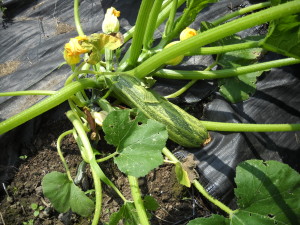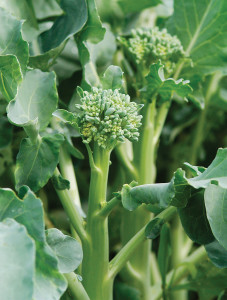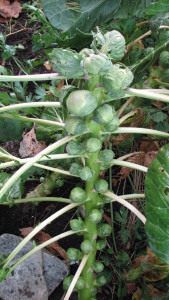Tips on Growing Vegetables, A to Z
It’s time to start thinking about the vegetable garden. We had frost recently, and will again, but this is a good time to think about what to plant. I can’t cover all plants I will grow – or have in the past – but I’d like to share a few tips on plants I love, starting with artichoke and going to zucchini.
Twenty years ago it was unheard of to grow artichokes in a New England garden. The first time I grew an artichoke from seed it developed into a huge plant, but didn’t start to produce “chokes” until cold weather came in the fall. So I built a little plastic-sheathed hoop house over it, and harvested my one and only artichoke in October – after snow! The local paper sent a reporter and a photographer.
Here’s what I’ve learned since that first effort: start early. I planted seeds March 3 this year in 6-packs and transplanted seedlings into bigger plastic pots in mid-April. Now the plants have 4 large leaves, and are ready to go to my cold basement (45 degrees) where I will set them up under lights on a timer, giving only 10 hours of light per day for the next10 days. This will fool those poor artichokes into thinking they have gone through a winter. Artichokes, you see, usually only produce in their second year. I’ll plant mine outside in early June. In California, artichokes are perennial – though I’ve never succeeded in overwintering them here.
Now locally grown artichokes are sold at farm and seedlings are sold, too, in case you haven’t started any. They will produce lovely foliage plants – and a few small artichokes. Some farms grow them in unheated greenhouses to stimulate them to produce their first year.
“B” is for beans. There are many varieties; all can be placed in one of two categories: bush beans or pole beans. Bush beans produce a nice yield of beans over a 3 to 4 week period, and are done. Pole beans, once they start producing, will continue to produce some beans until fall – if you keep picking them. Not only that, pole beans are better for casual gardeners, as many varieties still are yummy even if the beans are not picked on time and get large. Bush beans that get large, get woody. My favorite pole bean is ‘Kwintus’ from Cook’s Garden Seeds. ‘Kentucky Wonder’ is also great, and available everywhere.
Beans are legumes, and have nodules in their roots that can harbor nitrogen-fixing bacteria. These bacteria take nitrogen from the atmosphere and fix it in the soil – transforming it into nitrogen useable by plants. Free fertilizer, if you will. You can buy a packet of inoculant at garden centers. Wet your beans at planting time, then sprinkle the inoculant on the beans, and plant. A packet of inoculant will do a lot of beans, but won’t work next year, so share your leftovers with another gardener. And if you don’t get any in time, you can sprinkle it over the soil and water it in.
“B” is also for broccoli. I start mine by seed, but it’s getting a bit late for that now if you want early broccoli. But it is plentiful at garden centers, and quite cold-tolerant once hardened off and well established. You can plant seeds outdoors by seed in mid-July for a fall crop.
My favorite broccoli substitutes are two relatives that don’t ever produce a big head, but are quick-growing and produce very numerous mini-heads, what we would call side-shoots on broccoli. One is called piracicaba, and is available from Hudson Valley Seed Library (www.seedlibrary.org). It’s actually a tropical broccoli, so does well in the heat so summer when many others are feeling wilted and sad.
The other is Happy Rich, a hybrid sold by Johnny’s Selected Seeds (www.johnnyseeds.com). Like piracicaba, it has a lovely flavor – and you can eat the leaves and stems if you are so inclined. It produces all summer and well into the fall.
The last of the “B” vegetables, for today, at least, is Brussels sprouts. This vegetable is not universally well loved – too many cooks and lunch counters over cook it, serving mushy sprouts. But they are wonderful if lightly steamed and served with butter or vinegar.
Some gardeners never get big Brussels sprouts because they let the plants grow taller and taller, putting all their energy into growing tall. So here is what you need to do: cut off the top of the plant in early September. Labor Day at 10 am, to be precise. Cut off the top 3 to 4 inches, which is where upward growth occurs. Then the plant will use its energy to create big sprouts.
Skipping forward to “Z” as promised, my favorite zucchini is one called ‘Romanesco’. It has a striped, ridged exterior and firm flesh that is very tasty. What’s wonderful about it is that, unlike many summer squash and other zucchini, the flesh is still tasty and usable even if the squash goes unnoticed and develops into a big fruit.
Romanesco zucchini plants are rarely found at garden centers, but seeds are readily available. Buy the seeds now, plant outdoors in June or early May indoors in 4-inch pots.
Sorry I skipped a few vegetables in this year’s tips, but there will be more in future columns. Meanwhile, I’m going outside to plant some carrots – they come after the “B’s”.
Read Henry’s blog at https://dailyuv.com/
Choose Something New to Grow this Year
Before we launch into this week’s article…
Gardening Classes with Henry
Lebanon College: Gardening: A Practical Workshop. Garden writer Henry Homeyer will teach you the basics of organic vegetable and flower gardening. From garden design to seed-starting , planting, watering, weeding, mulching, and harvesting, this course will give each student practical knowledge of gardening. Tuesday nights from 6:30-8:30 for 5 weeks, April 3-May 2.Contact Lebanon College to reserve a spot for this5-part workshop www.lebanoncollege.edu or call 603-448-2445.
AVA Gallery, Lebanon. Henry will teach 3 classes at AVA Gallery this spring. You may sign up for one or all of these workshops:
Sculpting the Living Landscape: Starting Flowers from Seed
April 9; Monday, 6:30–8:30pm; One 2-hour class
Sculpting the Living Landscape: Perfect Perennials for the Upper Valley Garden
April 23; Monday, 6:30–8:30pm; One 2-hour class
Sculpting the Living Landscape: Organic Techniques for Enriching Soil and Managing Pests
May 7; Monday, 6:30–8:30pm; One 2-hour class
For more information go to www.avagallery.org or call 603-448-3117.
Choose Something New to Grow this Year
Spring is coming, spring is coming! The robins and red-winged blackbirds are back. Cardinals are singing their mating songs. It’s too early to do anything outside in the garden – or even for starting most things by seed indoors. But this is the time to make decisions, buy seeds if you haven’t, and plan. I want to offer some ideas about plants you may not usually grow – but should.
President George H.W. Bush hated broccoli. I can’t imagine why. Broccoli is not only tasty fresh, it’s great all winter if you freeze and store it properly. But maybe, if he reads this column on the internet (www.Gardening-guy.com), he’ll be willing to try one of the lesser known broccoli relatives that I grow and love. Happy Rich is one. Piracicaba is the other. Let me sing their virtues.
Happy Rich is a hybrid green created by crossing broccoli with something called gailon or Chinese kale. According to the Johnny’s seed catalog (www.johnnyseeds.com), it is just 55 days to harvest and produces lots of florets that “have an excellent sweet broccoli flavor”. My standard broccoli, ‘Diplomat’ is 68 days to harvest – about 2 weeks longer.
I love the flavor of Happy Rich – and the name, even though it has not, as yet, made me rich. I sometimes eat the leaves and stems, too. They steam up nicely, and the stems don’t get woody the way broccoli stems do. And if you go away for a week and the florets turn into full blossoms, they are still tasty! It produces until late fall.
Selected in Brazil for heat tolerance, Piracicaba (pronounced “peer-a-Cee’ca-bah”) is another broccoli-type plant that does not produce a big head, but produces lots of side shoots. It is like Happy Rich in almost all ways. I have grown it a few times, but never saved any seeds. My usual source doesn’t have it this year, but Google helped me find seeds: Hudson Valley Seed Library (www. seedlibrary.org) has it. This is a small seed company that values locally grown, open pollinated seeds. Membership (not required) is $25 and you get 10 packs of seeds free! I joined, and ordered lots of seeds, including some very interesting tomato varieties.
Unlike Happy Rich, piracicaba is open pollinated: it is not a hybrid, so I can save seeds. Let me digress here for a moment: modern hybrid seeds often produce plants with desirable qualities. Hybrids are created by crossing 2 specific parents. But you can’t generally do this yourself, as often the parent plants are not commercially available. And controlling pollen flow can be complicated. But if a catalog calls a plant “open pollinated” or “heirloom”, you can save seeds –though some insect-pollinated heirlooms need a considerable distance between varieties to prevent cross pollination). Squashes and pumpkins, for example, hybridize to create the “monsters” growing in your compost pile.
Rutabagas are wonderful root vegetables – I am still eating some from last summer. They look like turnips, but are sweeter and nicer. I’ve never had any pests or diseases on my plants, and they produce lots of food. I boil mine, and often mash them like potatoes, or use orange juice instead of milk for a slightly different flavor.
Then there is kale. Some years I put 50 quart bags of kale in the freezer so that I can use kale in soups and stir fries all year. The great thing about kale is that, unlike spinach, it doesn’t lose its texture when frozen or cooked. I blanch the kale for about a minute in boiling water before freezing (so that the enzymes that cause aging are destroyed) and it tastes fresh and wonderful right from the freezer many months after picking.
Kohlrabi is one more lesser-known vegetable you might want to try this year – I love it. It comes in both purple and green skinned varieties. It is a funny looking plant with stems coming out of the above-ground thickened stem that is the edible part. I like it raw in salads or cooked in a stir fry. Most varieties are baseball-sized and only 38-45 days to harvest. This year I am trying one from Johnny’s Seeds called ‘Kossak’ which is 80 days to harvest, but gets to be 8 inches in diameter, and keeps in storage for 4 months!
Since I am advising you to expand your gardening and cooking palate, I will do so, too. This year I will plant salsify and scorzonera, two long, irregular-shaped root crops. Scorzonera has black skin and white flesh; salsify is white skinned and is sometimes called oyster plant. Thomas Jefferson loved it, and grew it in quantity – which encourages me to try it. Roots of both are 8-10 inches long, so it needs loose, deep soil, which I have. I found seed at Johnny’s Seeds and will plant some directly in the soil once it warms up.
Cooking is the handmaiden of gardening. If you are adventurous in the kitchen, try some new veggies in the garden this year. If you discover an exceptional variety, please let me know! Just go to my Web site (www.Gardening-guy.com) to contact me.
Henry Homeyer is the author of 4 gardening books. His latest is Organic Gardening (Not Just) in the Northeast: A Hands-On, Month-by-Month Guide.








